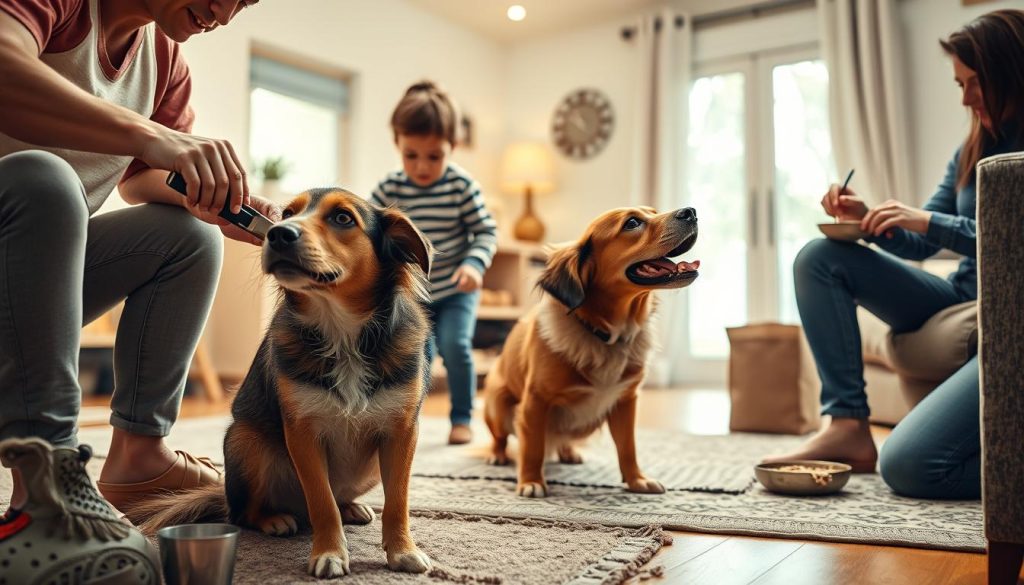Bringing home a new pet is exciting, but it needs careful planning. This ensures a smooth transition for both the pet and your family.
Experts at Countryside Veterinary Hospital say introducing a new pet can be tough. But, with the right approach, it can be a positive experience for everyone.
Preparing your home and picking the right pet are key steps. It’s also important to think about your family dynamics and pet compatibility. This helps create a harmonious environment.
Key Takeaways
- Prepare your home before bringing home a new pet.
- Choose a pet that is compatible with your family dynamics.
- Manage the introduction process carefully to avoid stressing the pet.
- Consider the needs and personalities of both the new pet and your existing family members.
- Create a safe and welcoming environment for your new pet.
Preparing Your Home for a New Pet
To make your new pet feel at home, you need to pet-proof your space and get the right supplies. This will help your pet feel comfortable and reduce stress for both of you.
Pet-Proofing Your Living Space
Pet-proofing is key to getting your home ready. It means removing dangers and making your space safe.
Removing Hazards and Toxic Items
First, get rid of toxic stuff, electrical cords, and small things that pets might swallow.
Securing Furniture and Valuables
Make sure heavy furniture and valuable things are safe. This prevents them from getting damaged or falling over.
Essential Supplies to Purchase
Getting the right supplies is crucial for your pet’s comfort and health.
Food and Feeding Equipment
You’ll need to buy food, a water bowl, and the right feeding tools for your pet.
Bedding, Toys, and Comfort Items
Give your pet a comfy bed, toys, and other things to make them feel at home.
Creating a Safe Space for Your New Pet
Make a quiet spot for your pet to rest and feel safe.
Designated Areas for Rest and Privacy
This area should be quiet and away from drafts.
Temperature and Comfort Considerations
Keep the area warm and cozy. Offer a warm bed or blanket.
Choosing the Right Pet for Your Family Dynamic
Finding the right pet is key to a happy home. Your family’s lifestyle, schedule, and the pet’s traits are important. They help make sure your pet fits in well.
Assessing Your Family’s Lifestyle and Schedule
Think about your family’s lifestyle before getting a pet. How much time do you have for pet care? This includes exercise, feeding, and grooming. Busy families might prefer a low-maintenance pet like a cat or fish.
Considering Age, Size, and Energy Level
The pet’s age, size, and energy level matter a lot. High-energy pets need lots of exercise and play. Larger pets need more space to move around. A pet that fits your family’s energy and space will be happier and healthier.
Matching Pet Personalities with Family Members
Pets have their own personalities, just like people. Some pets are very social and loving, while others are more independent. Choosing a pet that matches your family’s personality can prevent conflicts and create a loving bond. For example, a patient and gentle pet is best for families with young children.
| Pet Type | Energy Level | Grooming Needs | Compatibility with Children |
|---|---|---|---|
| Dogs | High | Regular | Excellent |
| Cats | Low to Medium | Low to High | Good |
| Fish | Low | Low | Good for older children |
The First Day: Bringing Your New Pet Home
Bringing a new pet home is a big deal. It needs careful planning for a smooth start. The first day is key to a happy home. With the right steps, it can be a great experience for everyone.
Transportation Tips for a Stress-Free Journey
Getting your pet home safely is the first step. Use a carrier or pet seatbelt to keep them secure. Here are some tips for a calm trip:
- Keep the carrier or pet area clean and comfy.
- Reduce noise and distractions.
- Bring familiar items like toys or blankets.
Setting Up a Quiet Introduction Environment
When you arrive, make a quiet space for your pet. This helps them adjust without stress. Make sure the area is:
- Quiet and free from loud noises.
- Comfortable in temperature.
- Ready with food, water, and a litter box.
Giving Your Pet Time to Adjust
Let your pet explore at their own pace. Rushing can cause stress. Watch for signs like panting or hiding, and help them feel better.
Signs of Stress to Watch For
Look out for these stress signs in pets:
- Panting or yawning.
- Pacing or restlessness.
- Hiding or avoiding things.
Creating Positive First Impressions
Make the first meeting calm and gentle. Reward them for being calm with treats and praise. This helps make a good first impression.
By following these tips, you can make your pet’s transition smooth. This sets the stage for a happy and healthy relationship.
Tips for Introducing a New Pet to Your Family Members
Introducing a new pet to your family needs patience and a good plan. It’s important to think about what each family member needs. This helps everyone get along smoothly.
Introducing Adults to the New Pet
Adults should let the pet come to them first. This makes the first meeting positive. It helps build trust between the adult and the pet.
Helping Children Bond Safely with the New Pet
Teach kids how to be gentle and respectful with the pet. Supervising is crucial for the pet’s safety and the child’s well-being.
Age-Appropriate Interactions
Young kids should have short, supervised meetings with the pet. Older kids can help more, like feeding or walking the pet.
Teaching Respect and Boundaries
Teach kids to respect the pet’s space. Don’t disturb it when it’s sleeping or eating. This prevents bad reactions from the pet.
Special Considerations for Seniors and Individuals with Disabilities
When introducing a pet to seniors or those with disabilities, think about their needs. The pet’s lifestyle should match the individual’s. This ensures a good relationship for both.
| Family Member | Considerations | Tips for Introduction |
|---|---|---|
| Adults | Let pet approach first | Allow interaction at their pace |
| Children | Supervise interactions | Teach gentle, respectful interaction |
| Seniors/Individuals with Disabilities | Consider physical capabilities | Choose a pet that fits their lifestyle |
Introducing Your New Pet to Existing Pets
Introducing a new pet to your home needs careful planning. A slow and thoughtful approach helps your pets get along better. This way, they can adjust to each other smoothly.
Dog-to-Dog Introductions
Start by taking your dogs to a neutral place. This spot should not belong to either dog. Keep the first meeting short and watch their body language. Give treats for calm behavior.
A study showed that dogs introduced in a neutral area fight less.
Cat-to-Cat Introductions
Introducing cats needs patience. Begin by letting them get used to each other’s smells and sounds. Then, have a supervised meeting.
“The key to successful cat introductions is gradualness. Rushing the process can lead to stress and conflict.”
Dog-to-Cat and Other Cross-Species Introductions
Introducing different species requires extra care. Make sure your dog is well-trained and can be controlled. Give the cat a safe place to go if it feels scared.
Managing Territorial Behavior
Managing territorial behavior is key when introducing new pets. Create a peaceful space where all pets feel safe.
Resource Guarding Prevention
Resource guarding happens when pets feel their things are being taken. Give each pet its own food and toys. Manage mealtime carefully.
Creating Positive Associations
Positive associations between pets come from consistent training. Reward calm behavior around each other. This helps create a friendly atmosphere.
| Pet Type | Introduction Tips | Common Challenges |
|---|---|---|
| Dogs | Neutral location, monitor body language | Territorial behavior, resource guarding |
| Cats | Gradual introduction, scent swapping | Stress, hiding |
| Cross-Species | Controlled environment, safe zones | Predatory instincts, fear |
Establishing Routines and Boundaries
Creating a daily routine and clear boundaries makes your new pet feel safe and adjust to their new home. Experts say, “a consistent routine provides a sense of stability and reduces anxiety in pets” (New Additions). This stability is key for a happy home.

Setting Up Feeding and Exercise Schedules
Feeding your pet at the same times every day helps their digestion and prevents overeating. A daily routine that includes walks, playtime, and training sessions helps burn energy and keeps their mind sharp. Consistency is key to making these routines work.
House Training Basics
House training is crucial for your new pet. It means setting a schedule for bathroom breaks, praising them when they use the right spot, and gently correcting accidents. Patience and persistence are essential during this time.
Crate Training Methods
Crate training can help with house training. It means keeping your pet in a crate when you’re not home to prevent accidents. The crate should be comfy and not a punishment.
Positive Reinforcement Techniques
Positive reinforcement rewards good behavior with treats, praise, or play. It encourages good habits and strengthens your bond with your pet. It’s great for house training and teaching basic commands.
Teaching Family Rules and Consistency
It’s important that all family members agree on rules and boundaries for your new pet. Being consistent helps avoid confusion and makes the transition smoother. Family meetings can help establish and share these rules.
By setting routines and boundaries, you create a stable and loving home for your new pet. This makes for a harmonious household for everyone.
Health Considerations for Your New Pet
When you bring a new pet home, think about their health first. Good care from the start helps avoid future problems. It also makes your bond stronger.
First Veterinary Visit Essentials
Your first vet visit is key for your pet’s health. The vet will examine them, check for illness or injury, and give care tips. Don’t forget to ask about food, shots, and any health or behavior worries.
Try to schedule this visit within the first few days of bringing your pet home. This helps catch health issues early.
Vaccination and Preventative Care Schedules
Vaccines and care plans are crucial for your pet’s health. Your vet will tell you when to get shots based on your pet’s age and health. They’ll also talk about parasite control and dental care to keep your pet healthy.
Sticking to the recommended schedule helps prevent diseases. It ensures your pet stays healthy and happy.
Recognizing Signs of Illness During the Adjustment Period
Watch your pet closely during the first few weeks. Look for signs of illness like changes in appetite, vomiting, or lethargy. If you see these signs, call your vet right away.
Quick action can greatly improve your pet’s health and recovery.
Addressing Common Adjustment Challenges
Welcoming a new pet into your home can bring joy. But, it also comes with challenges. These can affect both your pet and your family. It’s important to handle these challenges well to create a peaceful home.
Managing Separation Anxiety
Separation anxiety is common when you get a new pet. Start by leaving your pet alone for short times. Then, slowly increase how long you’re away. Giving your pet a safe space or crate can make them feel better when you’re not there.
Dealing with Destructive Behaviors
Destructive behaviors like chewing or digging often come from anxiety or boredom. Make sure your pet has lots of toys and play with them. Watching your pet and changing their behavior can also help stop the damage.
When to Seek Professional Help
If your pet’s challenges don’t get better or get worse, you might need professional help. Experts in behavior and training can offer great advice on how to handle specific problems.
Behavioral Specialists vs. Trainers
It’s important to know the difference between behavioral specialists and trainers. Specialists work on fixing deep-seated behavior issues. Trainers focus on teaching obedience and specific skills.
Signs That Indicate Professional Intervention
If your pet shows signs like constant separation anxiety, aggressive behavior, or destructive actions, they might need a pro. A professional can help find the cause and create a plan to fix it.
| Challenge | Signs | Solution |
|---|---|---|
| Separation Anxiety | Destructive behavior when left alone, pacing, or distress | Gradual separation, crate training, calming aids |
| Destructive Behaviors | Chewing, digging, or other destructive actions | Provide adequate toys, exercise, and supervision |
| Aggressive Behavior | Growling, biting, or hissing | Consult a behavioral specialist or trainer |

Conclusion
Bringing a new pet into your family can be very rewarding. By following the tips in this article, you can make the transition smooth. A well-planned introduction helps everyone in your home feel happy and comfortable.
It’s important to know how your family works and what you like to do. This helps you pick a pet that fits well with your family. Things like the pet’s age, size, and energy level are important for a happy home.
Being patient and understanding is key when introducing a new pet. Make sure they have a safe place to go and stick to routines. Knowing about health issues is also important. With the right steps, a new pet can bring lots of joy and friendship to your family.






